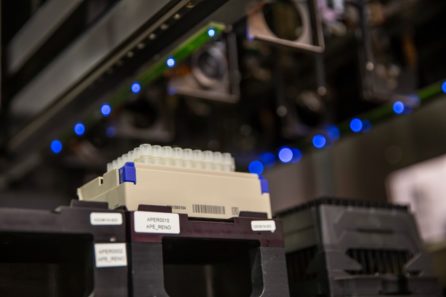Uncovering New Treatment Options for a Rare Disease
NewsThe Context: INAD is a rare neurological disease affecting children, often referred to as a “pediatric Parkinson’s,” which is typically diagnosed between six months to three years of age. It is caused by mutations in a single gene (PLA2G6), but presents differently in each child, and there are currently no treatments available.
The Study: NYSCF scientists made stem cell models from INAD patients, which in a recent international collaborative study were used to identify new features of the disease, as well as four potential drugs that could reverse these features. The team also tested a potential gene therapy in mice that delayed neurodegeneration and prolonged lifespan. The study, published in eLife, included NYSCF Research Institute scientists and was led by Baylor College of Medicine’s Hugo Bellen, DVM, PhD.
The Importance: This study pinpoints novel hallmarks of cells affected by INAD and offers potential therapeutic options for the disease in the form of drugs or gene therapy. These findings could also be used to further our understanding of related, more common diseases such as Parkinson’s.
“This research is focused on advancing our understanding of the underlying mechanisms of INAD so we can develop therapeutics to target the relevant pathways,” said INADcure, the patient advocacy charity that funded the work and a NYSCF partner. “Screening compounds on INAD disease models (including flies and patient cells) and pre-clinical gene therapy studies in mice provides valuable information that will help the research community and the INADcure Foundation in our mission to accelerate the development of therapeutics for INAD.”
Inside an INAD-affected Cell
NYSCF’s role in the study was to make stem cells from INAD-affected patients using NYSCF’s automated robotic platform, The NYSCF Global Stem Cell Array®. NYSCF has had a longstanding partnership with INADcure to collect cells from INAD patients and create human models of the disease to accelerate much-needed discovery. Our scientists then used gene editing technology to correct the disease-causing mutation in PLA2G6, and then converted both sets of stem cell lines into neurons, which are primarily affected in the disease.

“It seemed that the knowledge we can gain from looking at stem cells was important for understanding the disease mechanisms and ultimately coming up with a more effective treatment option,” noted INADcure founder Leena Panwala, whose daughter Ariya is affected with the disease.
A close look at these INAD-affected neurons, as well as examination of neurons from mouse models of INAD, suggested a few hallmarks of the disease, including defects in a cell’s protein trafficking and recycling system, metabolism, and alterations in the appearance of mitochondria.
Toward Better Treatments
The scientists then turned their attention to how these hallmarks could be reversed with potential drugs. They began by choosing 20 drugs (several of which are currently being explored as options for treating Parkinson’s disease). Testing these drugs on INAD-affected neurons created from stem cells, as well as fruit fly models of the disease yielded four candidates – Ambroxol, Desipramine, Azoramide, and Genistein – that could ameliorate INAD features.
The researchers then wondered whether targeting PLA2G6 directly could improve INAD prognosis. The team tested a gene therapy approach in mouse models, introducing a healthy version of the PLA2G6 gene to compensate for the malfunction of the mutated copy. Excitingly, mice who received the gene therapy showed delays in neurodegeneration as well as a prolonged lifespan. This exciting pre-clinical work suggests that such a therapy could be effective in humans.
Not only will all of this be important for INAD patients, but could also be informative for studies of more common diseases like Parkinson’s, which shares many characteristics with INAD.
“This study is an excellent demonstration of the power of stem cell models to help us understand and treat rare diseases,” said Rick Monsma, PhD, NYSCF’s SVP of Scientific Operations, who oversees the NYSCF laboratories. “NYSCF is proud to bring our technology to bear on this important, unmet need, and we are hopeful that the therapeutic leads from this study will pay off in our continued work with INADCure and Dr. Bellen’s lab.”
Journal Article:
Exploring therapeutic strategies for infantile neuronal axonal dystrophy (INAD/PARK14)
Guang Lin, Burak Tepe, Geoff McGrane, Regine C Tipon, Gist Croft, Leena Panwala, Amanda Hope, Agnes JH Liang, Zhongyuan Zuo, Seul Kee Byeon, Lily Wang, Akhilesh Pandey, Hugo J Bellen. eLife. 2023. DOI: https://doi.org/10.7554/eLife.82555
Cover image: Leena Panwala, co-founder of the INADcure Foundation, and her daughter, Ariya

